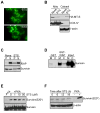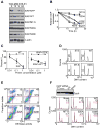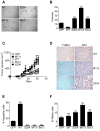Compartmentalized phosphorylation of IAP by protein kinase A regulates cytoprotection
- PMID: 17612487
- PMCID: PMC1986705
- DOI: 10.1016/j.molcel.2007.06.004
Compartmentalized phosphorylation of IAP by protein kinase A regulates cytoprotection
Abstract
Cell death pathways are likely regulated in specialized subcellular microdomains, but how this occurs is not understood. Here, we show that cyclic AMP-dependent protein kinase A (PKA) phosphorylates the inhibitor of apoptosis (IAP) protein survivin on Ser20 in the cytosol, but not in mitochondria. This phosphorylation event disrupts the binding interface between survivin and its antiapoptotic cofactor, XIAP. Conversely, mitochondrial survivin or a non-PKA phosphorylatable survivin mutant binds XIAP avidly, enhances XIAP stability, synergistically inhibits apoptosis, and accelerates tumor growth, in vivo. Therefore, differential phosphorylation of survivin by PKA in subcellular microdomains regulates tumor cell apoptosis via its interaction with XIAP.
Figures







Similar articles
-
Degradation of survivin by the X-linked inhibitor of apoptosis (XIAP)-XAF1 complex.J Biol Chem. 2007 Sep 7;282(36):26202-9. doi: 10.1074/jbc.M700776200. Epub 2007 Jul 5. J Biol Chem. 2007. PMID: 17613533
-
Inhibitors of apoptosis proteins (IAPs) expression and their prognostic significance in hepatocellular carcinoma.BMC Cancer. 2009 Apr 27;9:125. doi: 10.1186/1471-2407-9-125. BMC Cancer. 2009. PMID: 19397802 Free PMC article.
-
Therapeutic potential of siRNA-mediated combined knockdown of the IAP genes (Livin, XIAP, and Survivin) on human bladder cancer T24 cells.Acta Biochim Biophys Sin (Shanghai). 2010 Feb;42(2):137-44. doi: 10.1093/abbs/gmp118. Acta Biochim Biophys Sin (Shanghai). 2010. PMID: 20119625
-
An IAP in action: the multiple roles of survivin in differentiation, immunity and malignancy.Cell Cycle. 2004 Sep;3(9):1121-3. Epub 2004 Sep 15. Cell Cycle. 2004. PMID: 15326382 Review.
-
IAP family of cell death and signaling regulators.Methods Enzymol. 2014;545:35-65. doi: 10.1016/B978-0-12-801430-1.00002-0. Methods Enzymol. 2014. PMID: 25065885 Review.
Cited by
-
Akt inhibitor MK-2206 promotes anti-tumor activity and cell death by modulation of AIF and Ezrin in colorectal cancer.BMC Cancer. 2014 Mar 1;14:145. doi: 10.1186/1471-2407-14-145. BMC Cancer. 2014. PMID: 24581231 Free PMC article.
-
TGFβ and IGF1R signaling activates protein kinase A through differential regulation of ezrin phosphorylation in colon cancer cells.J Biol Chem. 2018 May 25;293(21):8242-8254. doi: 10.1074/jbc.RA117.001299. Epub 2018 Mar 29. J Biol Chem. 2018. PMID: 29599290 Free PMC article.
-
Survivin at a glance.J Cell Sci. 2019 Apr 4;132(7):jcs223826. doi: 10.1242/jcs.223826. J Cell Sci. 2019. PMID: 30948431 Free PMC article. Review.
-
The role of survivin in the progression of pancreatic ductal adenocarcinoma (PDAC) and a novel survivin-targeted therapeutic for PDAC.PLoS One. 2020 Jan 13;15(1):e0226917. doi: 10.1371/journal.pone.0226917. eCollection 2020. PLoS One. 2020. PMID: 31929540 Free PMC article.
-
Down-regulation of the antisense mitochondrial non-coding RNAs (ncRNAs) is a unique vulnerability of cancer cells and a potential target for cancer therapy.J Biol Chem. 2014 Sep 26;289(39):27182-27198. doi: 10.1074/jbc.M114.558841. Epub 2014 Aug 6. J Biol Chem. 2014. PMID: 25100722 Free PMC article.
References
-
- Abrams JM. Competition and compensation: coupled to death in development and cancer. Cell. 2002;110:403–406. - PubMed
-
- Altieri DC. Validating survivin as a cancer therapeutic target. Nat Rev Cancer. 2003;3:46–54. - PubMed
-
- Altieri DC. The case for survivin as a regulator of microtubule dynamics and cell-death decisions. Curr Opin Cell Biol. 2006;18:609–615. - PubMed
-
- Amieux PS, McKnight GS. The essential role of RI alpha in the maintenance of regulated PKA activity. Ann N Y Acad Sci. 2002;968:75–95. - PubMed
Publication types
MeSH terms
Substances
Grants and funding
LinkOut - more resources
Full Text Sources
Other Literature Sources
Molecular Biology Databases
Research Materials

